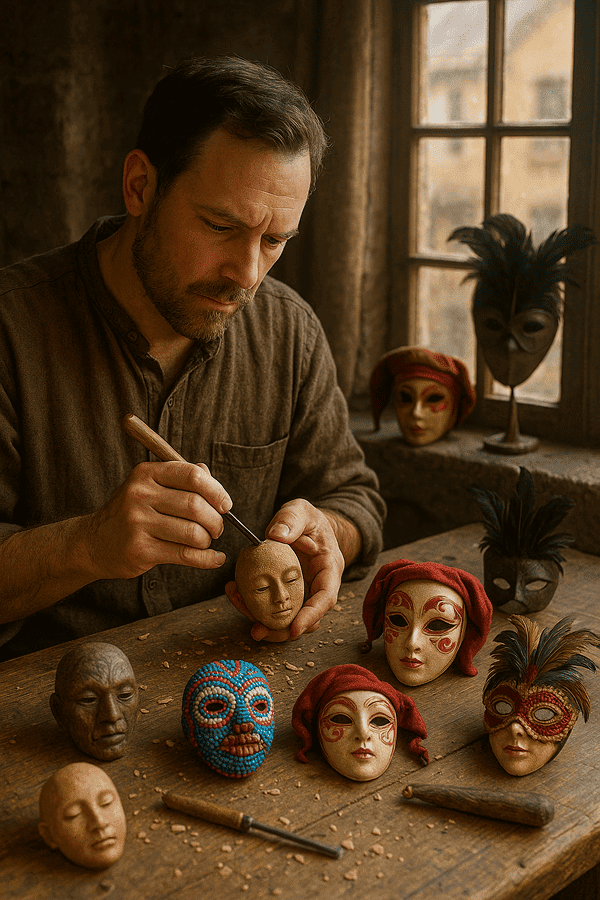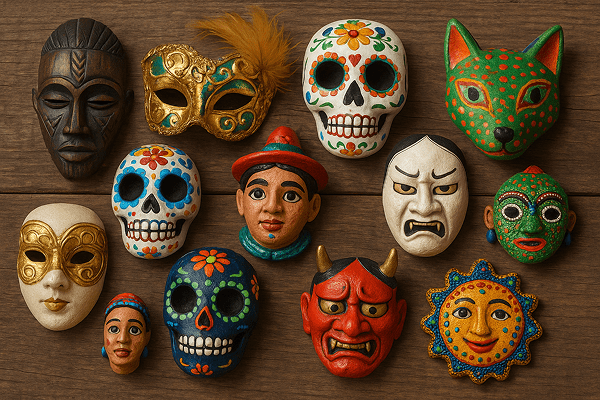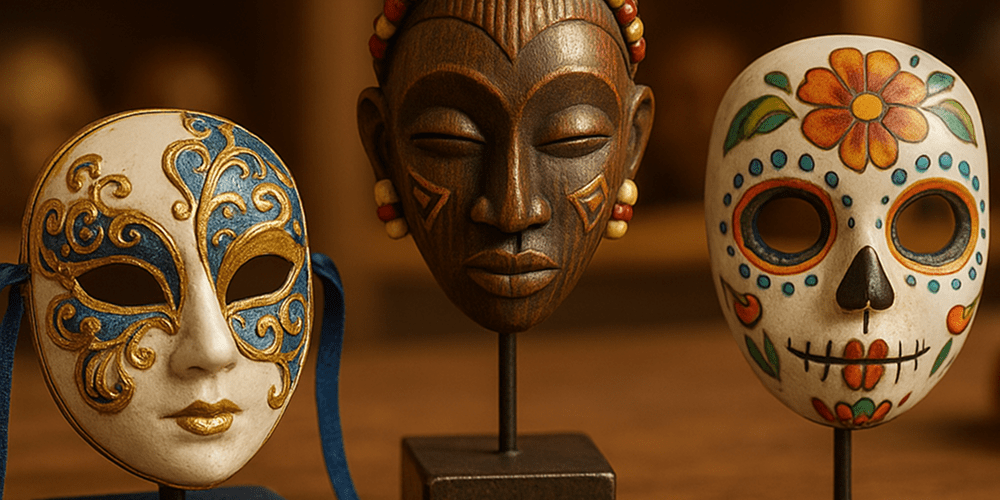Decorative Miniature Masks are small-scale works of art that capture the essence of world mask traditions in a compact, detailed, and highly collectible form. Typically measuring just a few centimeters to a hand’s breadth, these masks are prized for their intricate craftsmanship, vibrant colors, and the way they distill the identity of a culture or festival into a displayable object. Miniature Masks may be inspired by ceremonial, theatrical, or festival masks from Africa, Asia, the Americas, or Europe, but are primarily created for decorative, educational, or collecting purposes. They can be found in homes, museums, galleries, and artisan shops worldwide, and are closely related to other categories like Artistic Masks, which also blend creativity and cultural heritage (see more at toddmasks.com).
Historical Origins of Decorative Miniature Masks
The history of Decorative Miniature Masks is intertwined with the evolution of mask art and global trade. The word “miniature” comes from the Latin “miniare,” meaning to color with red lead, but in modern parlance, it means a small, detailed copy. As collectors and travelers brought home full-size masks from Africa, Asia, and the Americas in the 19th and 20th centuries, artisans began producing miniature versions for portability and as souvenirs.
In some cultures, mini-masks also served as amulets, talismans, or teaching aids, helping to pass down stories and rituals. The 20th century saw the growth of the souvenir market, with Venetian, Mexican, Japanese, and African workshops producing collectible miniatures alongside ceremonial masks. Today, artists and craftspeople around the world continue to innovate, using miniature masks as a way to celebrate cultural identity, experiment with materials, and engage with global audiences.
Cultural Significance and Symbolism of Decorative Miniature Masks
Miniature Masks, while primarily decorative, often retain the symbolic meanings of their full-sized counterparts. In West Africa, mini-masks may represent ancestral spirits, deities, or totemic animals, offering protection or good fortune. In Mexico, Day of the Dead mini-masks evoke themes of remembrance, celebration, and the cycle of life and death. Asian miniature masks can depict gods, demons, or legendary heroes, reflecting spiritual and mythological narratives.
Socially, giving or displaying a miniature mask can symbolize hospitality, friendship, or the memory of a journey. Myths and legends are frequently referenced in their design, making each mask a visual story. In the modern context, miniature masks also serve as tokens of appreciation, symbols of worldliness, or expressions of artistic taste.
Materials and Crafting Techniques of Decorative Miniature Masks
Miniature Masks are crafted from a wide range of materials, often chosen for their detail, durability, and ability to capture fine features:
- Carved wood (mahogany, ebony, balsa, cedar)
- Molded ceramics, porcelain, or clay
- Papier-mâché, resin, or composite materials
- Metal (bronze, silver, pewter, copper)
- Beads, glass, and mosaic
- Fabric, leather, and feathers
- Paint, gold leaf, and enamel

Techniques for miniature mask-making include:
- Hand-carving or molding using fine tools
- Casting and slip-molding for ceramics or metals
- Detailed painting and glazing
- Inlay, beadwork, and collage
- Mounting on stands, magnets, or pins for display
Regional differences are apparent: African mini-masks may use bold carving and natural pigments, Venetian mini-masks are often gilded and hand-painted, and Japanese miniatures may use lacquer or delicate brushwork. Color symbolism — red for life, black for protection, white for spirit — is often retained, even at miniature scale.
Functions and Uses of Decorative Miniature Masks
Decorative Miniature Masks serve a variety of roles:
- Decorative display: On shelves, shadow boxes, or walls as part of a collection.
- Gifts and souvenirs: Given as tokens of appreciation, friendship, or travel memories.
- Educational tools: Used to teach about world cultures, festivals, and mask traditions.
- Protective talismans: In some cultures, mini-masks are used as amulets or charms.
- Festival or holiday decoration: Integrated into themed displays for Carnival, Halloween, or Day of the Dead.
- Collectible art: Sought by mask enthusiasts and art collectors as part of themed or global collections.
Over time, the use of mini-masks has expanded from ritual or souvenir to include modern art, interior design, and even jewelry.
Regional Variations of Decorative Miniature Masks
The diversity of Decorative Miniature Masks reflects global creativity:
- African mini-masks: Bold geometric carving, animal motifs, and earthy tones.
- Venetian mini-masks: Gold leaf, feathers, baroque designs, and vibrant paint.
- Mexican mini-masks: Day of the Dead skulls, festival animals, and folk saints in bright colors.
- Japanese and Asian mini-masks: Noh, Kabuki, and festival characters in lacquer, ceramic, or metal.
- South American mini-masks: Carnival and folk figures with mosaic, beadwork, or painted details.
Local specialties might include signature shapes, materials, or decorative techniques, making each region’s mini-masks unique.

Famous Examples and Notable Collections of Miniature Masks
Decorative Miniature Masks are featured in museums, galleries, and private collections worldwide:
- Victoria and Albert Museum (London): Miniature masks from Europe, Africa, and Asia.
- International Museum of Folk Art (Santa Fe): Global mini-mask collections.
- Museo Nacional de Antropología (Mexico City): Mexican Day of the Dead miniatures.
- Private and online collections: Artisan-signed masks, limited editions, and themed sets.
Art fairs, cultural festivals, and online platforms like toddmasks.com often showcase new designs and collectible mini-masks, sometimes alongside full-sized Artistic Masks.
Influence of Miniature Masks on Art and Culture
Decorative Miniature Masks have had a notable impact on art, design, and popular culture. Their forms inspire painters, sculptors, jewelry designers, and illustrators. In literature and film, mini-masks may symbolize memory, identity, or the act of collecting and preserving culture.
In interior design, miniature masks are used to create global, eclectic, or personalized displays. Their small size makes them ideal for modern living spaces and accessible to new collectors. The ongoing creation and appreciation of mini-masks help keep mask traditions alive and relevant.
Contemporary Status and Preservation of the Miniature Mask Tradition
Miniature Mask-making is a dynamic and growing field. Modern artisans experiment with new materials, digital design, and eco-friendly practices. Art schools, museums, and cultural organizations offer workshops and exhibitions focused on mini-masks.
Online resources like toddmasks.com provide educational content, artist interviews, and curated galleries. Preservation efforts include documentation, community teaching, and support for artisan cooperatives. Collectors contribute to the tradition by supporting artists and sharing their collections with wider audiences.
Collecting and Acquiring Decorative Miniature Masks
The market for Decorative Miniature Masks is active and accessible. Masks can be found at art fairs, museum shops, specialty boutiques, souvenir markets, and online platforms such as toddmasks.com. Prices range from a few dollars to hundreds for artisan or limited-edition pieces.
Tips for collectors:
- Seek original designs and quality craftsmanship
- Support living artisans and ethical trade
- Look for documentation, artist signatures, or edition numbers
- Avoid mass-produced or counterfeit items
- Consider display, conservation, and provenance
Many collectors mix mini-masks with other decorative objects to create rich, layered displays.
